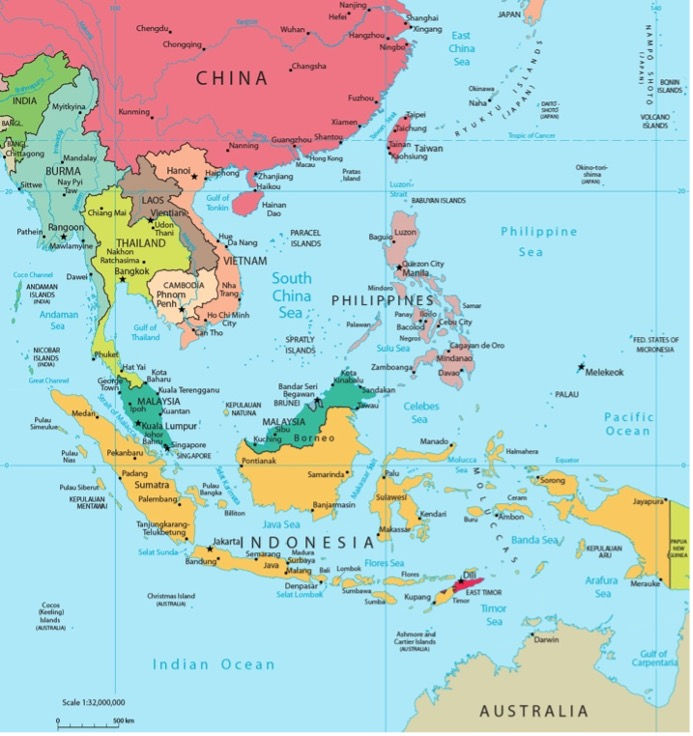SINGAPORE: A BRIEF HISTORY
- chuckmeltzer
- Jun 15
- 4 min read
Updated: Jul 19
Here's a concise overview of Singapore. The Republic of Singapore is an island nation and city-state located at the southern tip of the Malay Peninsula.
For those unfamiliar with the region, I have included this map:

Its modern history began in 1819 when Stamford Raffles founded it as a trading post for the British Empire. Singapore was occupied by Japan in 1942 and returned to British rule in 1945. It achieved self-governance in 1959 and joined the federation of Malaysia in 1963, but ideological differences led to its expulsion in 1965. Despite lacking natural resources, Singapore has become a significant hub for aviation, finance, and maritime shipping. Singapore excels in key social indicators such as education, healthcare, quality of life, personal safety, infrastructure, and housing, boasting a home-ownership rate of 88%.
Our guide explained how the government has successfully achieved these high home ownership rates through a public housing system where the government constructs apartments and sells 99-year leases. In this system, the government monitors potential buyers to maintain a balanced representation among various demographic groups: Chinese (74%), Malay (14%), and Indian (9%). Although the homes are not inexpensive, they are more affordable than private condos, costing about $1.2M for a 1200 square foot unit, which is about the cost of a condo in San Diego. After five years, residents can sell their lease to a new owner. We visited one of these buildings, which differ from the subsidized rental public housing commonly seen in the U.S. Instead, they are well-maintained and decent structures. We were impressed by their ability to provide housing for everyone, as we did not encounter any homeless people in Singapore. One building we visited, known as Block 88, is a bit austere and utilitarian, yet it is commendable that they have achieved this for most of the population. This tower was 50 stories high with views of some of the estates of those affluent Asians aka "crazy rich Asians"!!!!
Under the leadership of Governor Raffles, Singapore grew and prospered. While initially it was inhabited by mostly people from Malay, by 1860 half of the population of 80,000 were Chinese immigrants.
Singapore was not impacted much during WW I, and afterwards, the British built a large Singapore Naval Base to protect the port and its interests. As WW II loomed, it became more apparent that the Japanese were working their way down from Manchuria towards Malay and Singapore. As Great Britain came under attack at the start of WW II, it left Singapore not as well defended by this naval base as had been intended. The Japanese invasion of Malay culminated in the Battle of Singapore and a British force of 60,000 troops surrendered on 15 February 1942, with about 5000 killed or wounded. The British surrendered after just a week of fighting in February 1942. The Japanese had strategically outmaneuvered them, despite having only a third of the troops. They also launched their attack on Singapore from Thailand, which was unforeseen. The formal surrender took place at what used to be a Ford factory. Most of the British troops were from Australia. The Japanese experienced similar numbers of total killed or wounded. Overall, it was a significant loss for the British and one that delayed plans by them to liberate Singapore in 1945/1946.
The post-war period was chaotic and a critical time in its history to understand how Singapore evolved as to become a self-governing nation. I will spare you all the details, and fast forward to say it became independent on 9 August 1965 with Lee Kuan Yew as the first prime minister. Lee Kuan Yew encouraged rapid economic growth while putting limitations on internal democracy. His party, the PAP, People’s Action Party, remains in power. The second prime minister did not take office until 1990, and in 2004, Lee’s son, became the third prime minister. The minority Workers’ Party holds 10 of the 93 seats in their parliament and on 15 May 2024, the fourth prime minister took off and he was the first one born after the independence.
Let's touch on politics a bit more before returning to our travel experiences. What we truly value in our travels and explorations is gaining a deeper understanding of the people, their culture, and politics, which we don't always study before visiting these places. Last year's journey to Germany and then to Hungary was very enlightening regarding the political evolution of post-war Germany compared to Hungary under Viktor Orban. Learning about Singapore and its politics reveals a society that has thrived under a more rigid autocracy than what we have experienced in the US. The Singaporean government comprises three branches: Executive, Legislature, and Judiciary. The President is elected, and although the role has limited responsibilities, one of them is appointing the prime minister, who leads the executive branch. Singapore has consistently been ranked as one of the least corrupt countries globally, despite being illiberal. One of our guides mentioned that while he values the safety and quality of life, he wishes the government wouldn't dictate personal choices, like prohibiting chewing gum, as he sees it as an individual right.

















Comments